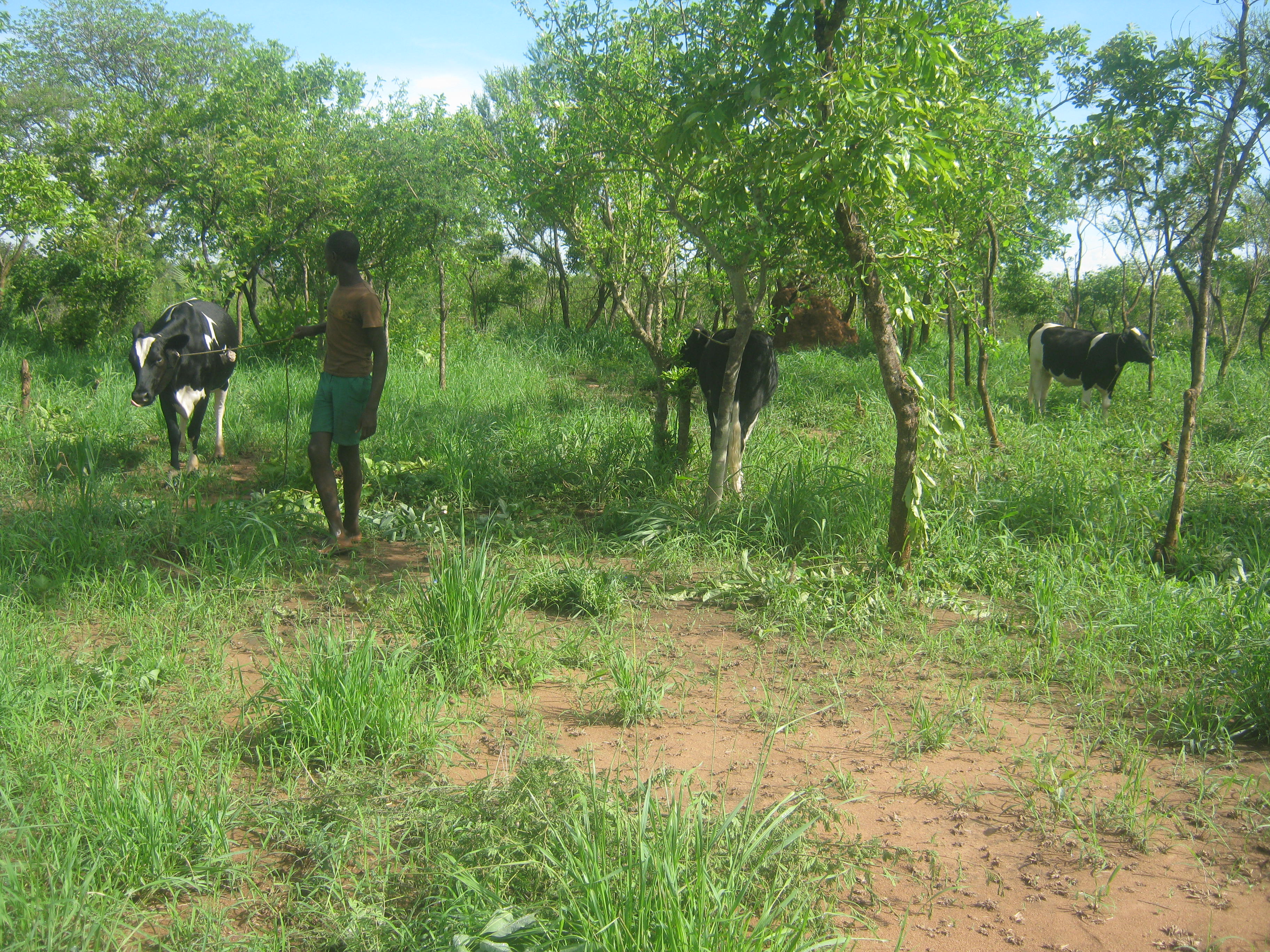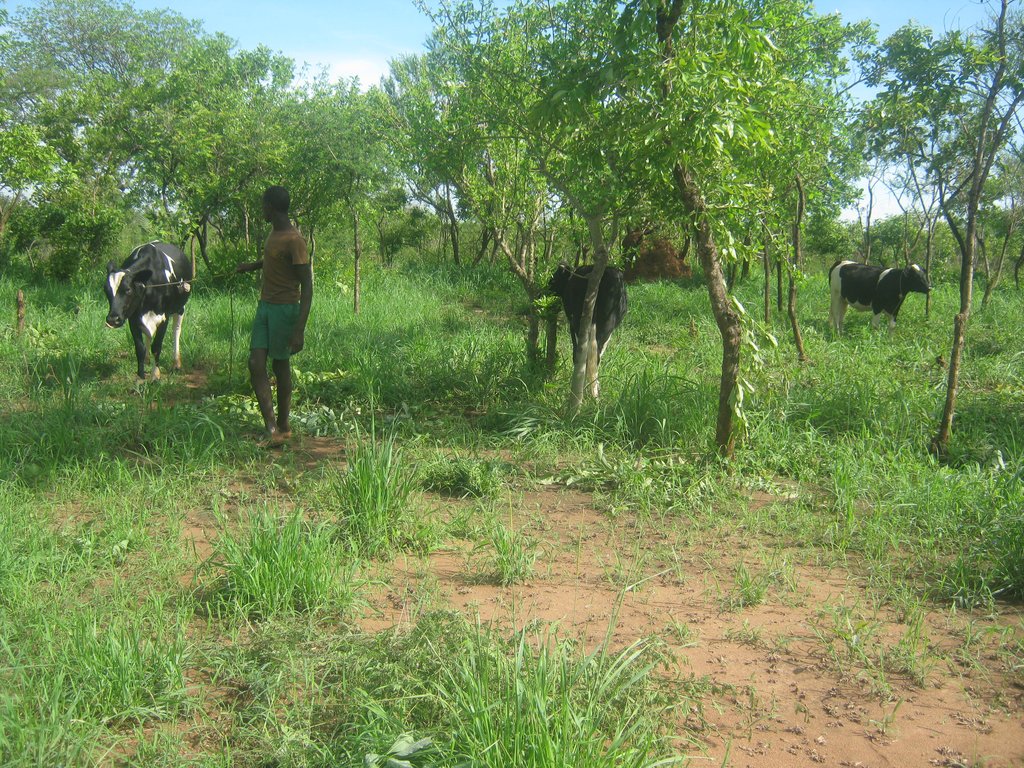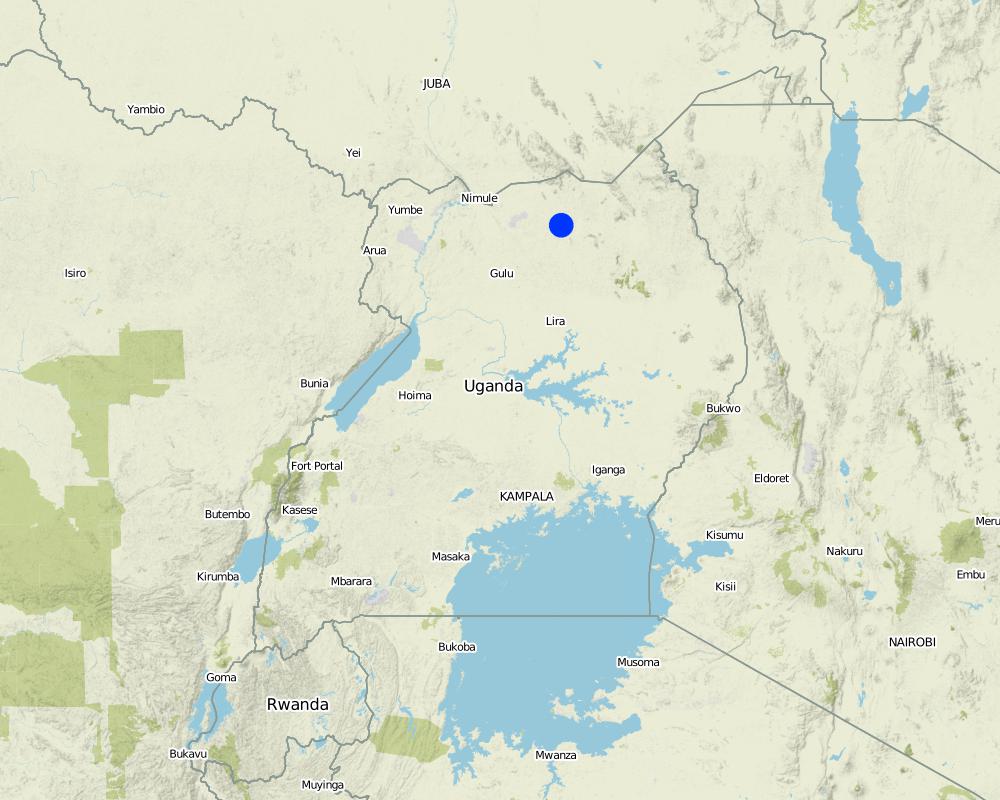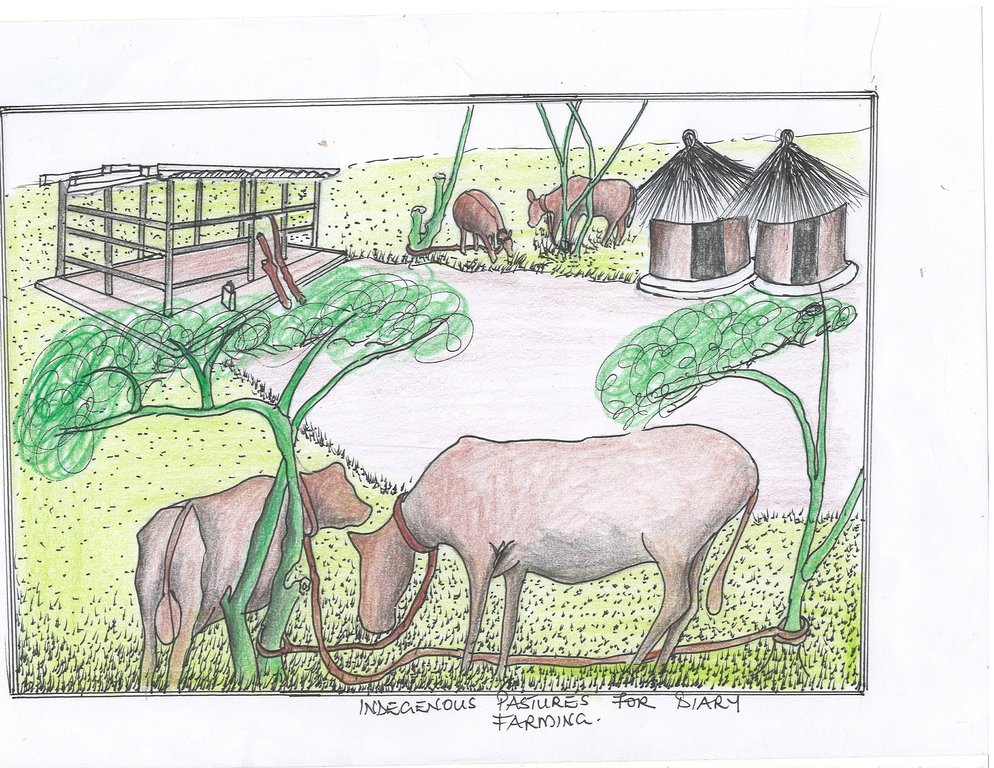Reclamation of indigenous pastures for dairy farming [Uganda]
- Creation:
- Update:
- Compiler: betty adoch
- Editor: JOY TUKAHIRWA
- Reviewers: John Stephen Tenywa, Nicole Harari, Renate Fleiner, Stephanie Jaquet, Rima Mekdaschi Studer, Alexandra Gavilano
Lum pi dyang cak
technologies_2321 - Uganda
View sections
Expand all Collapse all1. معلومات عامة
1.2 Contact details of resource persons and institutions involved in the assessment and documentation of the Technology
Key resource person(s)
land user:
Geoffrey Olum
kitgum district, labongo amida sub county, lukwo village
Uganda
Name of project which facilitated the documentation/ evaluation of the Technology (if relevant)
Scaling-up SLM practices by smallholder farmers (IFAD)Name of the institution(s) which facilitated the documentation/ evaluation of the Technology (if relevant)
CDE Centre for Development and Environment (CDE Centre for Development and Environment) - Switzerland1.3 Conditions regarding the use of data documented through WOCAT
The compiler and key resource person(s) accept the conditions regarding the use of data documented through WOCAT:
نعم
1.4 Declaration on sustainability of the described Technology
Is the Technology described here problematic with regard to land degradation, so that it cannot be declared a sustainable land management technology?
لا
Comments:
Reclaimed pastures from crop land are used for grazing the cows.
2. Description of the SLM Technology
2.1 Short description of the Technology
Definition of the Technology:
Dairy cattle (Friesian) are grazed on indigenous pastures to promotes conservation of the indigenous grass species (guinea grass), which protects the soil against soil erosion and promotes biodiversity.
2.2 Detailed description of the Technology
Description:
Indigenous pasture-based dairy farming is a balance between managing the pasture and the cows to maximize sustainable profit and promotes conservation of the indigenous grass species which protects the soil against soil erosion and promotes biodiversity. Northern Uganda has tropical savannah climate which receives moderate amount of rainfall ranging from 750-1000mm per annum. This is sometimes characterised by prolonged dry spells which hamper other economic activities like crop production. Therefore, to avoid the climatic shocks, this technology was introduced by the land user to diversify his economic activity other than only relying on crop production. The land user is a typical subsistence farmer whose major source of income depends on dairy farming to support his livelihood.
In this SLM technology, indigenous pastures are conserved for dairy farming. This is due to the existence of savannah grassland vegetation which provide abundant pastures for cattle grazing. This has favoured the rearing of Friesian cow on a flat landscape. A 30x40meters land was highly preserved for this technology. Five (5) cows are kept on this grazing field occupied by natural pasture (elephant grass) that the land user conserve. These grass are nutritious and the cows healthily and freely graze on them during wet and dry season. However, their movement is controlled by the headsman to avoid crop damage.
In order to maintain these grasses, during dry season, the land user creates a fire line around the conserved grazing area. This is to prevent the spread of wild fire from the nearby bush since it is a serious occurrence in the community. The conserved grass dries up during dry season but the dairy cows graze on it and can still produce high volume of milk as during the wet season. A cow produces daily 15 to 20 litters, they are milked twice a day and the milk is taken to town for sale. Soda ash are given to the cows to raise their appetite for pastures and water. Cows are source of milk, which is sold to generate revenue to the farmer for school fees, medications and cow dung is applied in orchard gardens and tree plantations to boost soil fertility.
To establish this technology, One Friesian cow were donated to the land user by a government project and a grazing field was secured which used to be for crop growing. Water tank placed on the grazing field. The grasses were conserved for the cow and shrub trees also protected for shade. With the help of artificial insemination, more calves were produce and today the land user have five cows that freely graze the area although their movement is controlled by the headsman.
This technology conserve grasses which cover the soil from the effects of soil erosion, reduce incidence of wild fire in the area, the shrubs trees are also protected to provide shade to the cows in the grazing field which promotes farmer managed natural regeneration and the grazing cows spread dung around the field which boost soil fertility.
During dry spells pasture growth is retarded and also becomes less nutritious that makes the cows to become skinny and water shortages. Besides, these cows are prone to pests and disease attacks that requires constant monitoring and treatment.
2.3 Photos of the Technology
General remarks regarding photos:
The photo shows the natural environment and how they are protected.
2.4 Videos of the Technology
Comments, short description:
diary cow grazing on the natural pastures
Date:
19/05/2017
الموقع:
Kitgum District, Lukwor village,
Name of videographer:
Betty Adoch
2.5 Country/ region/ locations where the Technology has been applied and which are covered by this assessment
بلد:
Uganda
Region/ State/ Province:
Northern Uganda.
Further specification of location:
Kitgum Municipality
Specify the spread of the Technology:
- evenly spread over an area
If precise area is not known, indicate approximate area covered:
- < 0.1 km2 (10 ha)
Comments:
the GPS point indicate the land user farm site
2 acres of land gazetted for grazing the cows
Map
×2.6 Date of implementation
Indicate year of implementation:
2012
If precise year is not known, indicate approximate date:
- less than 10 years ago (recently)
2.7 Introduction of the Technology
Specify how the Technology was introduced:
- through projects/ external interventions
Comments (type of project, etc.):
knowledge provided by Dairy Development Authority (DDA).
3. Classification of the SLM Technology
3.1 Main purpose(s) of the Technology
- improve production
- reduce, prevent, restore land degradation
- conserve ecosystem
- preserve/ improve biodiversity
- adapt to climate change/ extremes and its impacts
- create beneficial economic impact
3.2 Current land use type(s) where the Technology is applied

أراضي الرعي
Extensive grazing:
- Ranching
Intensive grazing/ fodder production:
- Improved pastures
Animal type:
- cattle - dairy
- exotic breed (Friesian cattle) for milk productio
Comments:
Specify:
cows are milk on a daily basis and one cows generates 15-20 litres of milk
Livestock density (if relevant):
Five (5) cows
artificial insemination done to acquire a calf.
3.3 Has land use changed due to the implementation of the Technology?

الأراضي الزراعية
3.4 Water supply
Water supply for the land on which the Technology is applied:
- rainfed
Comments:
pastures depends on rain for growth
Water supply for the land on which the Technology is applied:
rainfed
Comments:
pastures depends on rain for growth
Number of growing seasons per year:
2
3.5 SLM group to which the Technology belongs
- agroforestry
- pastoralism and grazing land management
- improved plant varieties/ animal breeds
3.6 SLM measures comprising the Technology

vegetative measures
- V1: Tree and shrub cover
- V2: Grasses and perennial herbaceous plants

management measures
- M1: Change of land use type
Comments:
crop production garden was converted into a grazing ground.
3.7 Main types of land degradation addressed by the Technology

soil erosion by water
- Wt: loss of topsoil/ surface erosion
- Wg: gully erosion/ gullying

soil erosion by wind
- Et: loss of topsoil
- Ed: deflation and deposition

biological degradation
- Bc: reduction of vegetation cover
- Bh: loss of habitats
- Bf: detrimental effects of fires
Comments:
Dairy farming protects the soil from human induced activities like crop cultivation which exposes the top soils for erosion.
3.8 Prevention, reduction, or restoration of land degradation
Specify the goal of the Technology with regard to land degradation:
- prevent land degradation
- reduce land degradation
Comments:
promotes soil conservation
4. Technical specifications, implementation activities, inputs, and costs
4.1 Technical drawing of the Technology
Technical specifications (related to technical drawing):
2 acres of land measuring 30x40 meters secured for grazing the cows. A kraal is constructed on the grazing field to accommodate the cows in the night. Pegging is done to prevent the cows from moving to cropland and after some time like afternoon the cows are shifted to another spot to graze. But also at time the cows are left to graze in the field with controlled movement. A kraal/shade is constructed, roofed with 5 pieces of iron sheet and supported by timbers that stands at a height of about 4meters.
Author:
Betty Adoch.
Date:
19/05/2017
4.2 General information regarding the calculation of inputs and costs
Specify how costs and inputs were calculated:
- per Technology area
Indicate size and area unit:
2acres
other/ national currency (specify):
UGX
If relevant, indicate exchange rate from USD to local currency (e.g. 1 USD = 79.9 Brazilian Real): 1 USD =:
3718,0
Indicate average wage cost of hired labour per day:
3000shs
4.3 Establishment activities
| Activity | Timing (season) | |
|---|---|---|
| 1. | clearing thony trees | dry season |
| 2. | regeneration of pastures | dry season |
| 3. | constructing cattle shade | dry and wet |
Comments:
Dairy farming is easy to manage by a a farmer.
4.4 Costs and inputs needed for establishment
Comments:
Its quite expensive at the initial stage of technology establishment but maintenance is easy.
4.5 Maintenance/ recurrent activities
| Activity | Timing/ frequency | |
|---|---|---|
| 1. | Slashing the over grown grass | dry and wet |
| 2. | constant removal of thony trees | dry and wet |
| 3. | Refilling the water tank | wet and dry season |
| 4. | Rotational pegging | Dry and wet seasons |
| 5. | Taking/returing of cows to kraal every evening | dry and wet seasons |
| 6. | Replacing ropes to tie the cows during pegging | dry and wet seasons |
4.6 Costs and inputs needed for maintenance/ recurrent activities (per year)
Comments:
The management is easy by the farmer.
4.7 Most important factors affecting the costs
Describe the most determinate factors affecting the costs:
The labour for firebreaks during dry seasons and maintaining the farm.
5. Natural and human environment
5.1 Climate
Annual rainfall
- < 250 mm
- 251-500 mm
- 501-750 mm
- 751-1,000 mm
- 1,001-1,500 mm
- 1,501-2,000 mm
- 2,001-3,000 mm
- 3,001-4,000 mm
- > 4,000 mm
Specify average annual rainfall (if known), in mm:
900,00
Specifications/ comments on rainfall:
heavy rain in april, may, june, august, september and october. these reduces in july, november,december january , febuary and march.
Indicate the name of the reference meteorological station considered:
kitgum weather station
Agro-climatic zone
- sub-humid
savanna climate where rainfall is moderate and unreliable with hot temperatures throughtout the year.
5.2 Topography
Slopes on average:
- flat (0-2%)
- gentle (3-5%)
- moderate (6-10%)
- rolling (11-15%)
- hilly (16-30%)
- steep (31-60%)
- very steep (>60%)
Landforms:
- plateau/plains
- ridges
- mountain slopes
- hill slopes
- footslopes
- valley floors
Altitudinal zone:
- 0-100 m a.s.l.
- 101-500 m a.s.l.
- 501-1,000 m a.s.l.
- 1,001-1,500 m a.s.l.
- 1,501-2,000 m a.s.l.
- 2,001-2,500 m a.s.l.
- 2,501-3,000 m a.s.l.
- 3,001-4,000 m a.s.l.
- > 4,000 m a.s.l.
Indicate if the Technology is specifically applied in:
- not relevant
Comments and further specifications on topography:
generally flat landscape.
5.3 Soils
Soil depth on average:
- very shallow (0-20 cm)
- shallow (21-50 cm)
- moderately deep (51-80 cm)
- deep (81-120 cm)
- very deep (> 120 cm)
Soil texture (topsoil):
- medium (loamy, silty)
Soil texture (> 20 cm below surface):
- medium (loamy, silty)
Topsoil organic matter:
- medium (1-3%)
If available, attach full soil description or specify the available information, e.g. soil type, soil PH/ acidity, Cation Exchange Capacity, nitrogen, salinity etc.
fertile soil that support plant growth
5.4 Water availability and quality
Ground water table:
5-50 m
Availability of surface water:
good
Water quality (untreated):
good drinking water
Is water salinity a problem?
لا
Is flooding of the area occurring?
لا
Comments and further specifications on water quality and quantity:
water is safe for animal consumption.
5.5 Biodiversity
Species diversity:
- high
Habitat diversity:
- high
Comments and further specifications on biodiversity:
cows,goats,wild rats and plant species like shrub trees, grass all coexist in the area.
5.6 Characteristics of land users applying the Technology
Sedentary or nomadic:
- Sedentary
Market orientation of production system:
- mixed (subsistence/ commercial)
Off-farm income:
- less than 10% of all income
Relative level of wealth:
- average
Individuals or groups:
- individual/ household
Level of mechanization:
- manual work
Gender:
- men
Age of land users:
- middle-aged
- elderly
Indicate other relevant characteristics of the land users:
the land user supply a dairy in town where his farm milk are sold.
5.7 Average area of land used by land users applying the Technology
- < 0.5 ha
- 0.5-1 ha
- 1-2 ha
- 2-5 ha
- 5-15 ha
- 15-50 ha
- 50-100 ha
- 100-500 ha
- 500-1,000 ha
- 1,000-10,000 ha
- > 10,000 ha
Is this considered small-, medium- or large-scale (referring to local context)?
- small-scale
5.8 Land ownership, land use rights, and water use rights
Land ownership:
- individual, not titled
Land use rights:
- individual
Water use rights:
- communal (organized)
Comments:
need to acquire land title for security purposes.
5.9 Access to services and infrastructure
health:
- poor
- moderate
- good
education:
- poor
- moderate
- good
technical assistance:
- poor
- moderate
- good
employment (e.g. off-farm):
- poor
- moderate
- good
markets:
- poor
- moderate
- good
energy:
- poor
- moderate
- good
roads and transport:
- poor
- moderate
- good
drinking water and sanitation:
- poor
- moderate
- good
financial services:
- poor
- moderate
- good
6. Impacts and concluding statements
6.1 On-site impacts the Technology has shown
Socio-economic impacts
Production
fodder production
Quantity before SLM:
low
Quantity after SLM:
high
Comments/ specify:
Conserved pastures for cows.
fodder quality
Quantity before SLM:
low
Quantity after SLM:
high
Comments/ specify:
nutritious for grazing
animal production
Quantity before SLM:
low
Quantity after SLM:
high
Comments/ specify:
due to increased fodder production
Water availability and quality
water availability for livestock
Quantity before SLM:
low
Quantity after SLM:
high
Comments/ specify:
Water is stored in a tank for the animals.
Income and costs
farm income
Quantity before SLM:
low
Quantity after SLM:
high
Comments/ specify:
Through sales of milk.
economic disparities
Quantity before SLM:
highl
Quantity after SLM:
low
Comments/ specify:
Has his source of income.
Socio-cultural impacts
food security/ self-sufficiency
Quantity before SLM:
low
Quantity after SLM:
high
Comments/ specify:
Milk provide food to the land user.
SLM/ land degradation knowledge
Quantity before SLM:
low
Quantity after SLM:
high
Comments/ specify:
Aware of the importance of soil conservation.
conflict mitigation
Quantity before SLM:
low
Quantity after SLM:
high
Comments/ specify:
The grazing zone is secure from land disputes.
Ecological impacts
Soil
soil moisture
Quantity before SLM:
low
Quantity after SLM:
high
Comments/ specify:
Grass cover soil from the effects of evaporations retaining more soil moistures.
soil cover
Quantity before SLM:
low
Quantity after SLM:
high
Comments/ specify:
Grass protects the soil.
soil loss
Quantity before SLM:
high
Quantity after SLM:
low
Comments/ specify:
Prevents soil erosion.
Biodiversity: vegetation, animals
Vegetation cover
Quantity before SLM:
low
Quantity after SLM:
high
Comments/ specify:
Plants and trees exists.
plant diversity
Quantity before SLM:
low
Quantity after SLM:
high
Comments/ specify:
Conservation of trees and grass for the animals.
Climate and disaster risk reduction
emission of carbon and greenhouse gases
Quantity before SLM:
high
Quantity after SLM:
low
Comments/ specify:
Plants acts as carbon sink.
6.2 Off-site impacts the Technology has shown
water availability
Quantity before SLM:
low
Quantity after SLM:
high
Comments/ specify:
Water source has been secured to constantly supply water for the animals during wet and dry seasons and also for other domestic activities.
buffering/ filtering capacity
Quantity before SLM:
low
Quantity after SLM:
high
Comments/ specify:
Plants roots filters the underground water.
6.3 Exposure and sensitivity of the Technology to gradual climate change and climate-related extremes/ disasters (as perceived by land users)
Gradual climate change
Gradual climate change
| Season | increase or decrease | How does the Technology cope with it? | |
|---|---|---|---|
| annual temperature | increase | moderately | |
| seasonal temperature | dry season | increase | moderately |
| annual rainfall | decrease | moderately | |
| seasonal rainfall | wet/ rainy season | decrease | moderately |
Climate-related extremes (disasters)
Meteorological disasters
| How does the Technology cope with it? | |
|---|---|
| local rainstorm | moderately |
| local thunderstorm | moderately |
| local hailstorm | moderately |
Climatological disasters
| How does the Technology cope with it? | |
|---|---|
| heatwave | moderately |
| drought | moderately |
| land fire | moderately |
Biological disasters
| How does the Technology cope with it? | |
|---|---|
| epidemic diseases | moderately |
| insect/ worm infestation | moderately |
Comments:
the dairy animals are healthy
6.4 Cost-benefit analysis
How do the benefits compare with the establishment costs (from land users’ perspective)?
Short-term returns:
slightly positive
Long-term returns:
very positive
How do the benefits compare with the maintenance/ recurrent costs (from land users' perspective)?
Short-term returns:
positive
Long-term returns:
very positive
Comments:
Dairy cows produces a calf once a year after artificial insemination.
6.5 Adoption of the Technology
- 1-10%
If available, quantify (no. of households and/ or area covered):
05 household
Of all those who have adopted the Technology, how many did so spontaneously, i.e. without receiving any material incentives/ payments?
- 0-10%
Comments:
Farmers uses their own capital.
6.6 التكيف
Has the Technology been modified recently to adapt to changing conditions?
نعم
If yes, indicate to which changing conditions it was adapted:
- climatic change/ extremes
6.7 Strengths/ advantages/ opportunities of the Technology
| Strengths/ advantages/ opportunities in the land user’s view |
|---|
| Soils are protected from the effects of erosion. |
| Cow dungs are used as manure on orchard gardens. |
| Strengths/ advantages/ opportunities in the compiler’s or other key resource person’s view |
|---|
| Conservation of soil and improved soil fertility. |
| Vegetation modifies the micro climate through the conserved pastures. |
| Land protections from degradation by erosion. |
6.8 Weaknesses/ disadvantages/ risks of the Technology and ways of overcoming them
| Weaknesses/ disadvantages/ risks in the land user’s view | How can they be overcome? |
|---|---|
| Pests and diseases that affects the cows. | Spraying and treatments. |
| Inadequate pastures during dry seasons. | Supplement with maize brands,banana leaves, and hey. |
| Weaknesses/ disadvantages/ risks in the compiler’s or other key resource person’s view | How can they be overcome? |
|---|---|
| Water shortage during dry season. | Planning to build a better and larger tank. |
| Failure of artificial insemination. | Need to acquire a Friesian bull. |
7. References and links
7.1 Methods/ sources of information
- field visits, field surveys
1
- interviews with land users
1
When were the data compiled (in the field)?
11/05/2017
Links and modules
Expand all Collapse allLinks
No links
Modules
No modules






